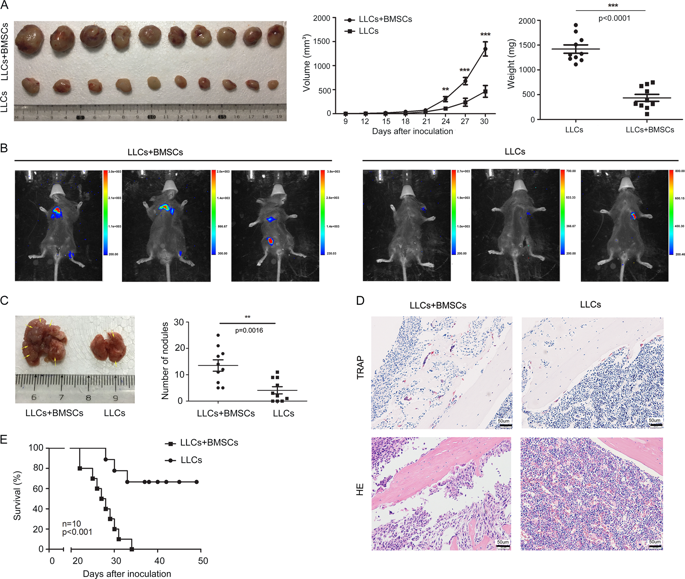当前位置:
X-MOL 学术
›
Cell Death Dis.
›
论文详情
Our official English website, www.x-mol.net, welcomes your
feedback! (Note: you will need to create a separate account there.)
Cancer-educated mesenchymal stem cells promote the survival of cancer cells at primary and distant metastatic sites via the expansion of bone marrow-derived-PMN-MDSCs.
Cell Death & Disease ( IF 8.1 ) Pub Date : 2019-12-09 , DOI: 10.1038/s41419-019-2149-1 Buqing Sai 1, 2, 3, 4 , Yafei Dai 1, 2, 3, 4 , Songqing Fan 5 , Fan Wang 1, 2, 3, 4 , Lujuan Wang 1, 2, 3, 4 , Zheng Li 1, 2 , Jingqun Tang 6 , Li Wang 6 , Xina Zhang 1, 2, 3, 4 , Leliang Zheng 1, 2, 3, 4 , Fei Chen 7 , Guiyuan Li 1, 2, 3, 4 , Juanjuan Xiang 1, 2, 3, 4
Cell Death & Disease ( IF 8.1 ) Pub Date : 2019-12-09 , DOI: 10.1038/s41419-019-2149-1 Buqing Sai 1, 2, 3, 4 , Yafei Dai 1, 2, 3, 4 , Songqing Fan 5 , Fan Wang 1, 2, 3, 4 , Lujuan Wang 1, 2, 3, 4 , Zheng Li 1, 2 , Jingqun Tang 6 , Li Wang 6 , Xina Zhang 1, 2, 3, 4 , Leliang Zheng 1, 2, 3, 4 , Fei Chen 7 , Guiyuan Li 1, 2, 3, 4 , Juanjuan Xiang 1, 2, 3, 4
Affiliation

|
Bone marrow mesenchymal stem cells (BMSCs) are multipotent stromal cells that can differentiate into a variety of cell types. BMSCs are chemotactically guided towards the cancer cells and contribute to the formation of a cancer microenvironment. The homing of BMSCs was affected by various factors. Disseminated tumour cells (DTCs) in distant organs, especially in the bone marrow, are the source of cancer metastasis and cancer relapse. DTC survival is also determined by the microenvironment. Here we aim to elucidate how cancer-educated BMSCs promote the survival of cancer cells at primary tumour sites and distant sites. We highlight the dynamic change by identifying different gene expression signatures in intratumoral BMSCs and in BMSCs that move back in the bone marrow. Intratumoral BMSCs acquire high mobility and displayed immunosuppressive effects. Intratumoral BMSCs that ultimately home to the bone marrow exhibit a strong immunosuppressive function. Cancer-educated BMSCs promote the survival of lung cancer cells via expansion of MDSCs in bone marrow, primary tumour sites and metastatic sites. These Ly6G+ MDSCs suppress proliferation of T cells. CXCL5, nitric oxide and GM-CSF produced by cancer-educated BMSCs contribute to the formation of malignant microenvironments. Treatment with CXCL5 antibody, the iNOS inhibitor 1400w and GM-CSF antibody reduced MDSC expansion in the bone marrow, primary tumour sites and metastatic sites, and promoted the efficiency of PD-L1 antibody. Our study reveals that cancer-educated BMSCs are the component of the niche for primary lung cancer cells and DTCs, and that they can be the target for immunotherapy.
中文翻译:

经过癌症训练的间充质干细胞通过骨髓来源的 PMN-MDSC 的扩增,促进原发灶和远处转移部位癌细胞的存活。
骨髓间充质干细胞(BMSC)是多能基质细胞,可以分化成多种细胞类型。 BMSC 被趋化引导至癌细胞,并有助于癌症微环境的形成。 BMSCs的归巢受到多种因素的影响。远处器官尤其是骨髓中的播散性肿瘤细胞(DTC)是癌症转移和癌症复发的根源。 DTC 的存活也由微环境决定。在这里,我们的目标是阐明经过癌症训练的 BMSC 如何促进原发肿瘤部位和远处部位癌细胞的存活。我们通过识别瘤内 BMSC 和移回骨髓的 BMSC 中的不同基因表达特征来强调动态变化。瘤内骨髓间充质干细胞具有高迁移率并表现出免疫抑制作用。最终归巢于骨髓的瘤内骨髓间充质干细胞表现出强大的免疫抑制功能。经过癌症训练的 BMSC 通过在骨髓、原发肿瘤部位和转移部位中扩增 MDSC 来促进肺癌细胞的存活。这些 Ly6G+ MDSC 抑制 T 细胞的增殖。由癌症培养的 BMSC 产生的 CXCL5、一氧化氮和 GM-CSF 有助于恶性微环境的形成。 CXCL5抗体、iNOS抑制剂1400w和GM-CSF抗体治疗减少了骨髓、原发肿瘤部位和转移部位的MDSC扩张,并提高了PD-L1抗体的效率。我们的研究表明,经过癌症培养的 BMSC 是原发性肺癌细胞和 DTC 生态位的组成部分,并且它们可以成为免疫治疗的靶点。
更新日期:2019-12-09
中文翻译:

经过癌症训练的间充质干细胞通过骨髓来源的 PMN-MDSC 的扩增,促进原发灶和远处转移部位癌细胞的存活。
骨髓间充质干细胞(BMSC)是多能基质细胞,可以分化成多种细胞类型。 BMSC 被趋化引导至癌细胞,并有助于癌症微环境的形成。 BMSCs的归巢受到多种因素的影响。远处器官尤其是骨髓中的播散性肿瘤细胞(DTC)是癌症转移和癌症复发的根源。 DTC 的存活也由微环境决定。在这里,我们的目标是阐明经过癌症训练的 BMSC 如何促进原发肿瘤部位和远处部位癌细胞的存活。我们通过识别瘤内 BMSC 和移回骨髓的 BMSC 中的不同基因表达特征来强调动态变化。瘤内骨髓间充质干细胞具有高迁移率并表现出免疫抑制作用。最终归巢于骨髓的瘤内骨髓间充质干细胞表现出强大的免疫抑制功能。经过癌症训练的 BMSC 通过在骨髓、原发肿瘤部位和转移部位中扩增 MDSC 来促进肺癌细胞的存活。这些 Ly6G+ MDSC 抑制 T 细胞的增殖。由癌症培养的 BMSC 产生的 CXCL5、一氧化氮和 GM-CSF 有助于恶性微环境的形成。 CXCL5抗体、iNOS抑制剂1400w和GM-CSF抗体治疗减少了骨髓、原发肿瘤部位和转移部位的MDSC扩张,并提高了PD-L1抗体的效率。我们的研究表明,经过癌症培养的 BMSC 是原发性肺癌细胞和 DTC 生态位的组成部分,并且它们可以成为免疫治疗的靶点。











































 京公网安备 11010802027423号
京公网安备 11010802027423号